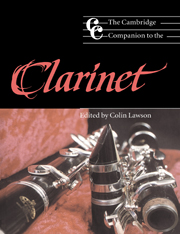Book contents
- Frontmatter
- 1 Single reeds before 1750
- 2 The development of the clarinet
- 3 The clarinet family
- 4 The development of the clarinet repertoire
- 5 Players and composers
- 6 The mechanics of playing the clarinet
- 7 Teaching the clarinet
- 8 Playing historical clarinets
- 9 The professional clarinettist
- 10 The contemporary clarinet
- 11 The clarinet in jazz
- 12 The clarinet on record
- Notes
- Appendices
- Select bibliography
- Index
10 - The contemporary clarinet
Published online by Cambridge University Press: 28 September 2011
- Frontmatter
- 1 Single reeds before 1750
- 2 The development of the clarinet
- 3 The clarinet family
- 4 The development of the clarinet repertoire
- 5 Players and composers
- 6 The mechanics of playing the clarinet
- 7 Teaching the clarinet
- 8 Playing historical clarinets
- 9 The professional clarinettist
- 10 The contemporary clarinet
- 11 The clarinet in jazz
- 12 The clarinet on record
- Notes
- Appendices
- Select bibliography
- Index
Summary
Why is the clarinet such a popular instrument among contemporary composers? Is it that, as a social group, clarinettists combine intellect, industry and experimentation with a happy disposition? Well, this may be a contributing factor, but a rather more probable hypothesis is that the instrument itself combines flexibility with a tonal palette ranging from woody, chuckling cosiness to seering, ear-splitting intensity. It is the clarinet's expressiveness, agility and richness of tone which has attracted composers and has led to the many close associations between composer and performer: a tradition which has resulted in the wealth of concertos and chamber music from the eighteenth and nineteenth centuries discussed in Chapter 5.
In the twentieth century this composer-player teamwork has blossomed, particularly in the post-Second World War period. Experimenting and researching together, composers have written pieces which could not have existed without the specific talents of certain instrumentalists. Each has influenced the other as the range of pitch and colour has been extended, multiphonics discovered and exploited, microtones played on orchestral instruments not built for them, circular breathing rediscovered, percussive, air and simultaneous vocal sounds all brought together to broaden the spectrum of sound possibilities.
The language and style of new music has become much more familiar to audiences during the last fifteen years or so and music by living composers is beginning to appear regularly in mainstream concert programming and recording. More performers are actively involved in playing new music alongside traditional repertoire and it is no longer a minority interest appealing only to the specialist. That's the good news. The bad news is that there is still an astonishing reluctance among many young players to play music written by living composers.
- Type
- Chapter
- Information
- The Cambridge Companion to the Clarinet , pp. 163 - 183Publisher: Cambridge University PressPrint publication year: 1995



